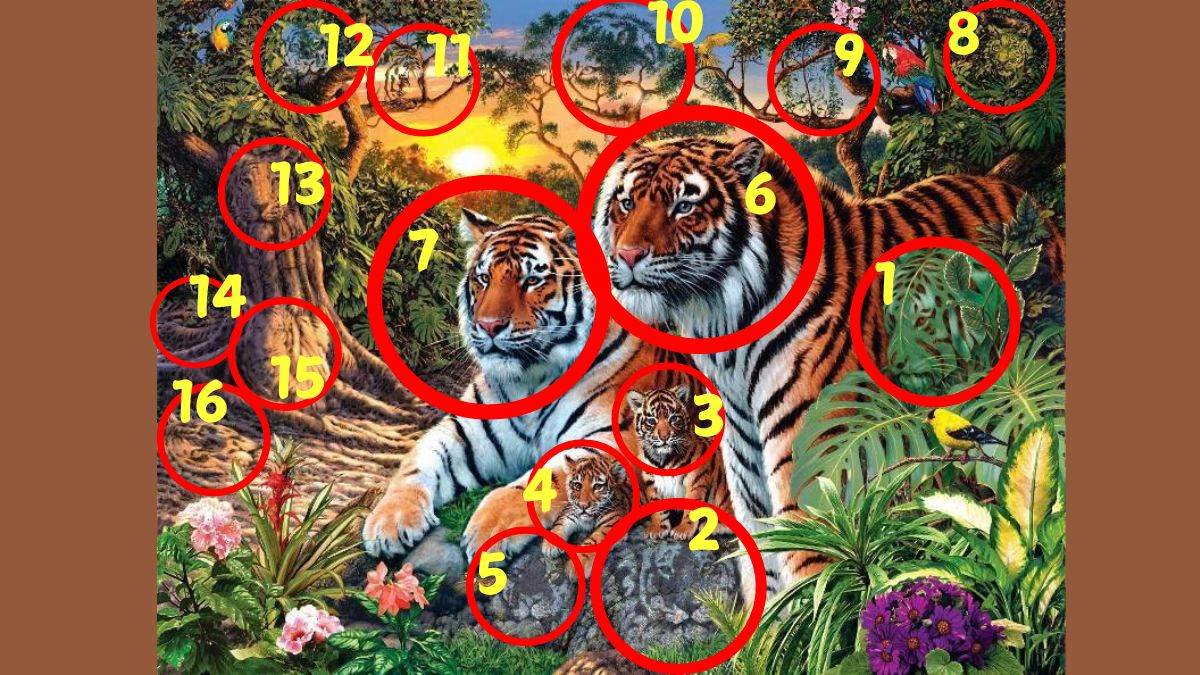An optical illusion is a type of visual puzzle that creates a misleading effect on our brain and leads to our brain's interpretations in the wrong way, and misleads our perception. This optical illusion generally occurs because the brain processes visual information by drawing on past experiences, context, and patterns, which can sometimes lead to incorrect conclusions.
Optical illusions can occur due to factors like perspective, light, colour, movement, or the arrangement of shapes. The optical illusions are generally classified into three types: literal illusions (images that differ from the objects creating them), physiological illusions (effects resulting from prolonged eye stimulation), and cognitive illusions (misinterpretations based on assumptions).
Are you ready for this optical illusion test? Today’s optical illusion is cleverly designed to test your perception. The image appears to be an illustrated scene featuring a jungle scene of tigers.
It looks like a tiger family (two adults and two cubs) resting in a vibrant jungle during sunset.
But, in this beautiful forest artwork, there are multiple tigers hidden within the artwork's optical illusion.
The challenge is to count the exact number of tigers in this beautiful optical illusion forest art scene.
Can you prove you have an IQ level of 140 or higher with 20/20 vision? Then, using your Hawk-Eye Vision with 20/20 Eyesight, count the exact number of tigers in this beautiful optical illusion forest art scene—within just 11 seconds!
Can you count the Exact Number of Tigers in this Beautiful Optical Illusion Forest Art Scene in 11 Seconds?

Source: pinterest
This is an optical illusion artwork that features a tiger family (two adults and two cubs) resting in a vibrant jungle during sunset. But when you look more closely at the trees, leaves, shadows, and background, you’ll notice that the artist has cleverly hidden the outlines of multiple tiger faces within the forest scenery.
But hidden somewhere in this vibrant composition is Multiple of Tigers—blending seamlessly into the background.
Your challenge? Use your HD-eye vision to locate the hidden Multiple of Tigesr without scrolling away or asking for hints.
So if you think that your IQ is higher than 100% of people, then by using your sharp Hawk-Eye Vision and observation skills and also using your 161+ IQ level, could you count the exact number of tigers in this beautiful optical illusion forest art scene in 11 seconds?
I think you all have now received a brief overview of the image, and you can now start your brain teaser challenge.
So, almost ready!
Then set the timer on your clock for 9 seconds
Ready… Get… Set… Go…
Yes, observe the image very carefully.
Use your sharp IQ skills.
Hurry up! Time is ending…
3…2…1… Stop! Stop! Time’s Up!
So, how was the challenge? Okay, congratulations to those who could have counted the exact number of tigers in this beautiful optical illusion forest art scene in 11 seconds; you all are geniuses, and you all possess Einstein-level 140+ IQ and vigilant-eye vision, and obviously, you are in the 1% of people who can solve this visual brain teaser.
Okay, now those who were not able to count the exact number of tigers in this beautiful optical illusion forest art scene in 11 seconds, they also do not worry.
Do practice these puzzles and brain teasers, and your IQ level, thinking skills, and problem-solving skills will be increased.
Solution for this beautiful Optical Illusion Forest Art Scene Challenge: How many Tigers are hidden?
So, are you excited to know how many Tigers are hidden in this beautiful optical illusion forest art scene?
Okay, first, look carefully at the image and count it. There are a total of 16 Tigers in this beautiful optical illusion forest art scene, and if still not found, the number of Tigers, look down in the image, it is circled.

Source: pinterest
So, now you all know how many Tigers are hidden in this beautiful optical illusion forest art scene test, and by solving this optical illusion challenge, you all have enjoyed it.
By practising these types of puzzles, your IQ will increase, and so will your observation and problem-solving skills.
Comments
All Comments (0)
Join the conversation